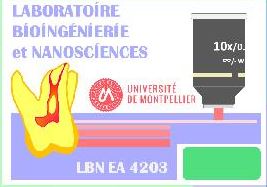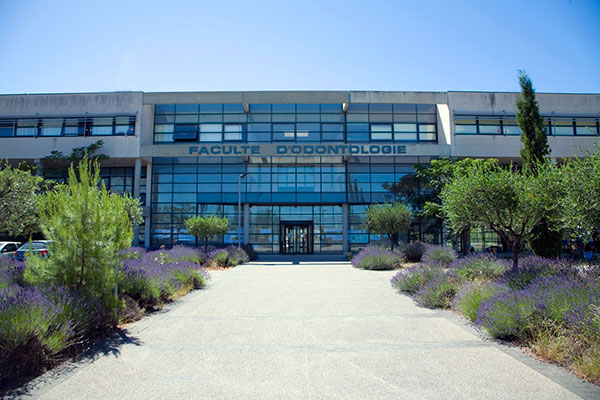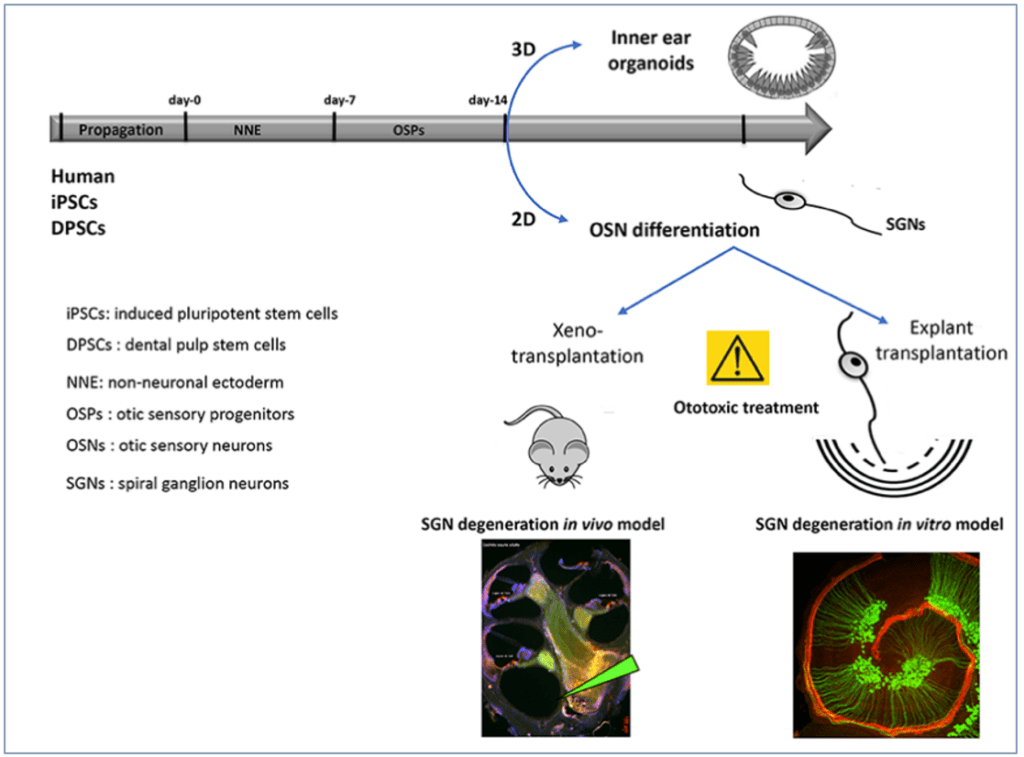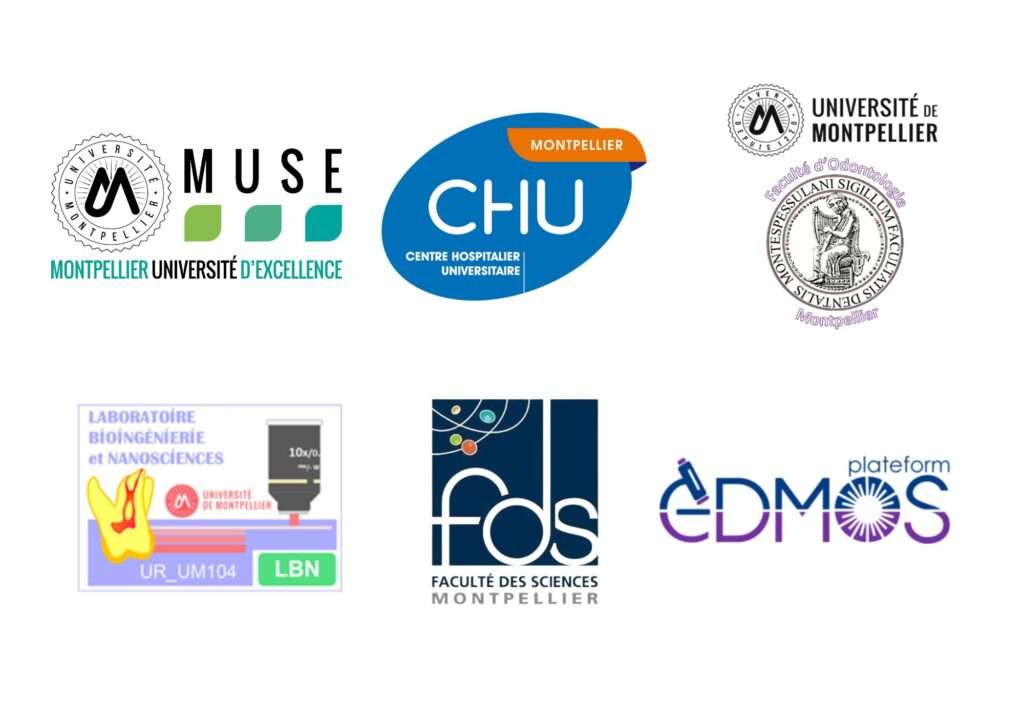Laboratoire de Bioingénierie et Nanosciences (LBN)


The LBN (laboratory for Bioengineering and Nanoscience) was created in 2007. LBN is known to combine specific inorganic scaffolds (porous silicon…) and innovative microscopy methods as Confocal Raman or multiphotonic microscopy for tissue engineering based on human dental pulp stem cells (DPSC) and induced pluripotent stem cells (iPS).
LBN is located at the heart of the Faculty of Odontology of Montpellier and directed by Professor Frédéric CUISINIER. The LBN is part of the scientific department Health Biology (DBS).
LBN is ISO9001 accredited for the public research process and the EDMOS platform is under certification for private research process.
Since 2021, the LBN hosts 3 interdisciplinary research groups and a technological platform.
The EDMOS platform is a collaborative platform combining technical facilities from LBN, Institut Mines Telecom Ales and CHU Montpellier.
The researchers belong to the Dental Faculty, the Pharmacy Faculty, and the chemistry department of the Science Faculty.
GROUP 1
PIERRE-YVES COLLART DUTILLEUL (GROUP LEADER)
- Jacques-Henri TORRES (PU PH)
- Valérie ORTI (PU PH)
- Stéphane BARTHELEMI (PU PH)
- Philippe BOUSQUET (MCU PH)
- Ivan PANAYOTOV (MCU PH)
- Marie-Alix FAUROUX (MCU PH)
- Jean Claude EGEA (MCU-PH)
- Eve MALTHIERY (MCU PH)
- Naveen FATIMA, PhD
- Sophia PIGLIONICO, PhD
TASKS
- Porous silicon for Dental Pulp Stem Cells proliferation and differentiation
- PEEK functionalization for cell adhesion and mineralized tissue formation
- Bifunctional peptide for epithelial adhesion on titanium
- Bone and cartilage formation followed by Raman spectroscopy
- DPSC for anticancer drug delivery
- DPSC Conditioned Medium for cell and tissue regeneration
GROUP 2
AZEL ZINE (PU, GROUP LEADER)
GROUPMEMBERS
- Azel ZINE (PU, Group leader)
- Veronique MONTERO (MCU)
- Olivier ROMIEU (MCU, PH)
- Richard YOUNES (Ph.D Student)
- Yassine MESSAT (Ph.D Student)
- Fidan HUSEYNOVA (Ph.D Student)
Sensorineural deafness is often caused by the degeneration of spiral ganglion neurons (SGN) in the inner ear that relay auditory signals to the brain. These SGN do not regenerate after degeneration. Dental pulp stem cells (DPSCs) are neural crest-derived ecto-mesenchymal stem cells as the cranial neural crest cells. (NCC) These NCC partially contribute to the SGN during development of the inner ear. DPSCs are promising candidates for cell therapy approach, because they have migratory properties, enabling migration after transplantation can differentiate into sensory neurons and glial cells and can be harvested in relatively high numbers. We hypothesize that human DPSCs can be used for cell-based regeneration and repair of the SGN.
Project 1: Production of human SGN from DPSC and iPSC using 2D and 3D cultures
The main goal of this task is to differentiate and characterize human otic neurosensory progenitors and SGN using a cellular platform for the in vitro production of differentiated cell types from either iPSCs or DPSCs. The stepwise guided differentiation of stem cells into SGN is not straightforward, since there is no single marker which can be applied to distinguish this specific cell type. However, by using RNA-seq high throughput gene expression, it will be possible to more thoroughly determine whether cohorts of known otic neurosensory progenitors and SGN markers over a sequential time course of in vitro differentiation. We will compare a global trajectory towards human otic neurosensory lineage in both DPSCs and iPSCs-derived otic neuronal progenitors and SGN. The development of identity/purity control experiments of otic neuroprogenitors and their neurosensory trajectories will be performed using confocal Raman Spectroscopy in collaboration with Team 3 and Edmos Platform.
Projet 2: Potential of sugar-based angiogenic on organoids vascularization during iPSC and DPSC toward SGN neurosensory differentiation
One of the unique aspects of organoid models is the ability to resemble, to some extent, the in vivo organ or tissue from which they were derived, and which allow for relevant cell-cell and cell-matrix interactions. One of the key limitations in using organoid approaches to generate tissues is that upon reaching a certain size, organoids cease to proliferate and develop a necrotic core. In order to maintain the complexity of organoids, it is necessary to prevent the appearance of the necrotic inner core leading to the premature differentiation in the outer layers of organoids. This phenomenon, in turn, was largely ascribed to a lack of organoid vascularization. We will explore a panel of angiogenic effectors derived from Mannose-6-phosphate (M6P) on the neurodifferentiation of either DPSC or iPSCs, and in the development of organoids vascularization
Project 3: Effects of transplantation neurosensory progenitors in models of SGN degeneration To test the regeneration and synaptogenesis abilities of DPSC/iPSC-derived otic neurosensory progenitors following engraftment, we will use first anin vitroco-culture model with denervated cochlear organotypic explants. We have previously demonstrated that hiPSCs derived otic progenitors are able to engraft and differentiate in the damaged cochlea (Lopez et al., 2019).

General outlouk of otic neurosesnory differentiation in vitro and engraftement in SGN degeneration models
COLLABORATIONS:
- Albert Edge (Harvard Medical School)
- John Devos (IRMB, CHU, Montpellier)
- Christian Chabbert (CNRS, AMU Marseille)
- Pierre Gaudriault (Cherry Biotech, Rennes)
- Annelies Schrott-Fischer (Medical University of Innsbruck, Austria)
GROUP 3
AMEL SLIMANI (GROUP LEADER)
- Hervé Tassery (PU-PH)
- Jean Valcarcel (PU-PH)
- Hamideh Salehi (PR)
- Michel Fages (PU-PH)
- Ivan Panayotov (MCU-PH)
- Jean Cédric Durand (MCU-PH)
- Alban Desoutter (technical assistant LBN)
- Elias Estephan (Associate Professor)
Our scientific objective is to identify new photonic biomarkers for oral diseases, mainly dental caries, periodontal diseases and oral cancer. These pathologies will be studied by different spectroscopic methods and devices. We organize this project according to the methods even if the methods can be combined to increase the specificity and the sensitivity of biomarkers.
1. 3D intraoralscanners(IOS):
Oral cancer is a significant health problem often identified at later stage. Oral cancers are characterized by a change of color of the tissues as well as oral mucosa thickening. Concerning thickening of tissue, obtaining 3D mesh of oral cavity is an interesting tool to create standardized biomarkers of cancerous lesions. Autofluorescence, color and 3D meshes could be combined to detect oral cancer. We will focus our work to explore the use of the two IOS in order to optimized cancer detection. For this 3D meshes from malignant lesions and sound tissue will be collected. Segmentation and color spectral analyze will lead to identify biomarkers through multivariate statistics. This can be extended to periodontal disease.
2. BCARS to detect the buccal cancer
The diagnosis of malignant and cancerous lesions in the oral cavity is the main interest in the development of the new imaging techniques. The malignant tissues make biochemical changes called tumor markers inducing variation in the vibrational spectra. Raman spectra from diseased and healthy tissue are compared for diagnosis. Raman biomarkers are complementary to biopsy and give real-time diagnosis. The first part of the task is to compare the existing standard biopsy analysis with our label free B-CARS signal. The relevant data analysis could detect the modification in tissue with the potential to be used in operating room.
3. Early caries lesions detection by Brillouin / Raman biomarkers
The initial caries lesions are challenging to detect for a dentist and even more in teledentistry. In our laboratory, we have developed a WSLin vitromodel and we used confocal Raman spectroscopy and multiphoton microscopy images to evaluate structural changes in the white spot lesion. The goal of this task is to adapt a new non-invasive biomedical imaging technology based on Brillouin light scattering to measure the biomechanical properties of hard tissues and biomaterials, is the main aim of this project. The molecular analysis of dental tissues using Raman spectroscopy is been used to characterize the mineral phase in synthetic compounds and natural tissues. Our project is to use confocal Raman microscopy coupled with a home-build Brillouin spectrometer. The first step will be to demonstrate the possibility of biomechanical/biochemical simultaneous imaging to obtain. photonic biomarkers for early caries and WSL diagnosis studying in-vitro incipient caries lesions, animal induced periodontal. Comparison with healthy samples will allow statistical analysis to find a biomarker to detect the caries in early level is the final step.
Partnerships:
1- L2C- UMR5221 CNRS: we will continue our strong collaborations through our involvement in the financing and building the BCARS (team Nanobiophonic) and the building of the Brillouin Spectrometer (B. Rufflé, D. Felbacq, team physics of glassy state). We will develop a partnership for colorimetry in teledentistry (F. Geniet, team complex system and nonlinear phenomena).
2- LIRMM: all works of metrology for IOS are discussed and conducted with LIRMM (G. Subsol, ICAR team).
3- LNE: concerning the metrology of IOS, characterization of object and samples tested, we have a collaboration with a team of LNE (Laboratoire National de Métrologie et d’Essai, Nimes).
EDMOS PLATFORM
EVALUATION DES DISPOSITIFS MÉDICAUX EN ODONTOLOGIE ET STOMATOLOGIE

EDMOS platform is a consortium of laboratories and research centers linked for one purpose: design, innovation and development of dental medical devices.
EDMOS regroup 3 main structures:
- LBN laboratory
- C2MA laboratory
- Montpellier University Hospital Dental Clinic
Our Objectives: To create a partnership between the private sector and the leading academic scientists. To offer our technical platforms to industrials interested in the development of dental medical devices.
Projects and contracts with the EDMOS platform include the preparation of patents and scientific publications based on the processed and qualified data to provide scientific validation of your device or product.
MORE INFORMATION : HTTPS://EDMOS.EDU.UMONTPELLIER.FR/
